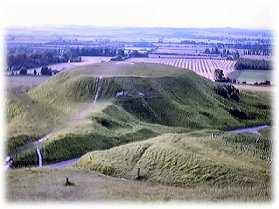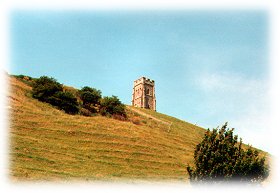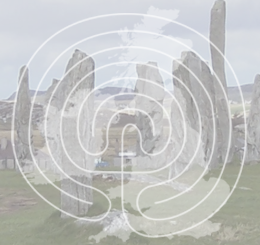St. Illtyd’s Well, Llanrhidian
St. Illtyd’s Well or the Butter Well as it is also known, can be found in a private garden near the Church of St Rhydian and St Illtyd in Llanrhidian. It acquired the name Butter Well after an event in the 12th century when milk apparently flowed from it for three hours.
 According to British Goblins (1881) by Wirt Sykes, ‘Wells from which milk has flowed have been known in several places….The well of St. Illtyd is celebrated for the like performance. This well is in Glamorganshire, in the land called Gower, near Swansea. It was about the nativity of John the Baptist, on the fifth day of the week, in a year not specified*, but certainly very remote, that for three hours there flowed from this well a copious stream of milk instead of water. That it was really milk we are not left in any possible doubt, for ‘many who were present testified that while they were looking at the milky stream carefully and with astonishment, they also saw among the gravel curds lying about in every direction, and all around the edge of the well a certain fatty substance floating about, such as is collected from milk, so that butter can be made from it.’
According to British Goblins (1881) by Wirt Sykes, ‘Wells from which milk has flowed have been known in several places….The well of St. Illtyd is celebrated for the like performance. This well is in Glamorganshire, in the land called Gower, near Swansea. It was about the nativity of John the Baptist, on the fifth day of the week, in a year not specified*, but certainly very remote, that for three hours there flowed from this well a copious stream of milk instead of water. That it was really milk we are not left in any possible doubt, for ‘many who were present testified that while they were looking at the milky stream carefully and with astonishment, they also saw among the gravel curds lying about in every direction, and all around the edge of the well a certain fatty substance floating about, such as is collected from milk, so that butter can be made from it.’
The origin of this well is a pleasing miracle, and recalls the story of Canute; but while Canute’s effort to command the sea was a failure in the eleventh century, that of St. Illtyd five hundred years earlier was a brilliant success. It appears that the saint was very pleasantly established on an estate consisting of a field surrounded on all sides by plains, with an intermediate grove, but was much afflicted by the frequent overflowings of the sea upon his land. In vain he built and rebuilt a very large embankment of mud mixed with stones, the rushing waves burst through again and again.
At last the saints patience was worn out, and he said, “I will not live here any longer; I much wished it, but troubled with this marine molestation, it is not in my power. It destroys my buildings, it flows to the oratory which we built with great labour.” However, the place was so convenient he was loth to leave it, and he prayed for assistance. On the night before his intended departure an angel came to him and bade him remain, and gave him instructions for driving back the sea. Early in the morning Illtyd went to the fluctuating sea and drove it back; it receded before him ‘as if it were a sensible animal,’ and left the shore dry. Then Illtyd struck the shore with his staff, and thereupon flowed a very clear fountain, which is also beneficial for curing diseases, and which continues to flow without a falling off; and what is more wonderful, although it is near the sea, the water emitted is pure.
The Annals of Margam suggests that the year the milk flowed was 1185.
The ‘Parochiale Wallicanum’ (1875) tells us that, ‘St. Rhidian’ is not very well authenticated, and the Annals of Margam (year 1185) mention a St. Illtud’s Well at [Llanridian in Gower], which suggests an original dedication of the church to that Saint” (Owen’s Pembrokeshire, ii, 408.) Samuel Lewis ascribes the church to Illtyd, whose well must be that described by him as the “Holy Well, on Cevn y Bryn mountain, to; which, in former times, miraculous efficacy was attributed : it was generally frequented on Sunday evenings during the summer season by numbers of persons, who drank the water, and, according to an ancient custom, threw in a pin as a tribute of their gratitude” (Top. Die. Wales, ed. 1833). With regard to the chapels of Llanrhidian, see Owen’s Pembrokeshire, ii, 357. See also note to Llandridian, s St. Nicholas, in Deanery of Pebidiog (Pembrokeshire).




Re: St. Illtyd’s Well, Llanrhidian
The Explore Gower website gives the following folk tale concerning Llanrhidian entitled ‘Gnomes’ Gold’
The first concerns a priest who is said to have awakened one morning from a gripping dream concerning a mysterious cave hidden in the woods near St. Rhidian’s Church. His vivid dream foretold the cave contained a bountiful supply of money, so the priest decided to take his manservant and investigate the area.
To his surprise, the priest soon discovered the cave actually existed. The dream had told the priest that the awesome iron door that blocked the entrance to the cave would only open to the sound of a harp. Forewarned with this knowledge, he now played a tune on the small harp he had brought along with him from his home.
As promised by his dream, the iron door responded to the sweet music and swung slowly open. Inside the cave, each guarded by a sleeping gnome, were two large piles of gold. Lulled by the sound of the priest’s harp, the gnomes continued to sleep as the priest’s manservant crept into the cave to steal some of the gold for his master. However, the gold was heavy and, despondent by the paltry amount of gold his manservant could carry, the priest laid down his harp to help in the theft of the gnomes treasure. Unfortunately, as the harp ceased its tune, the iron door swung firmly shut behind the priest and both men were trapped within the cave to face the wrath of the two stirring gnomes. The location of the cave has remained a mystery ever since.